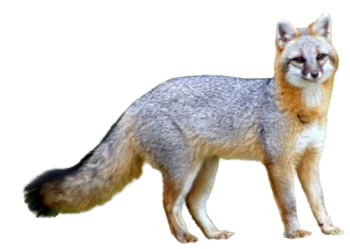
The Gray Fox (Urocyon cinereoargenteus) is an omnivorous canid known for its agility and ability to climb trees. This fox is primarily found in North America and Central America.
The Gray Fox is distinguished by its gray fur with hints of red and white. It measures approximately 76 to 112 cm in length, including its tail, and weighs between 3.6 and 7 kg. Its tail is long and bushy, often with a black tip.
The Gray Fox belongs to the Canidae family.
This fox is one of the most widespread carnivore species in North America and Central America.
The Gray Fox is extremely adaptable and can be found in a wide range of habitats: forests, prairies, deserts, agricultural areas, and even suburban areas. Its ability to climb trees allows it to escape predators and feed on fruits and small arboreal animals.
This canid is primarily solitary but can form family groups during the breeding season. Active mainly at dusk and dawn, the Gray Fox is an opportunistic hunter, using its keen hearing to locate prey under snow or in vegetation.
Omnivorous, the Gray Fox feeds on a variety of prey: rodents, birds, insects, fruits, and berries. In urban environments, it can even scavenge through trash. This diverse diet illustrates its ability to thrive in changing environments.
Although the Gray Fox is not endangered, it faces threats such as hunting, diseases like rabies, and collisions with vehicles. Its reputation as a pest can also lead to persecution.
The Gray Fox belongs to the genus Urocyon, which also includes the Island Fox (Urocyon littoralis). These two species share unique characteristics within the Canidae family, notably their ability to climb trees.
The Gray Fox belongs to the genus Urocyon, which also includes the Island Fox (Urocyon littoralis). These two species share unique characteristics within the Canidae family, notably their ability to climb trees.
To observe the Gray Fox in its natural or urban habitat, follow these tips:
By following these recommendations, you can admire this fascinating animal while minimizing disturbances.